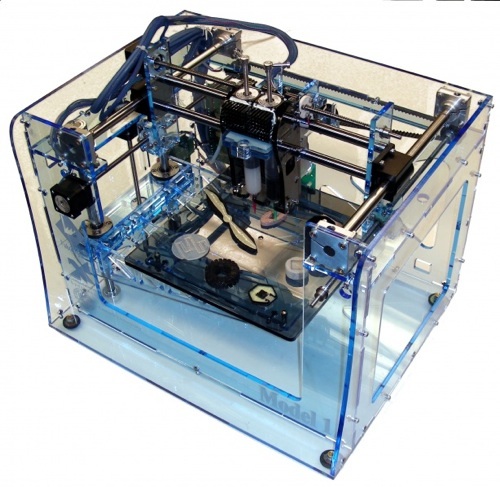Evan Malone was one of the crucial people behind the Fab@Home project which demonstrated to many that desktop 3D printing was not a pipe dream but a usable technology. He has now founded NextFab Studio and the NextFab Organization. NextFab Studio is a Philadelphia based organization that is a hackerspace that you can go to in order to make & invent things. The NextFab Organization hopes to spread learning and information about all the open source design and fabrication technologies available. I am a fanboy and tried not to swoon.
Joris Peels: Will everyone really make everything?
Evan Malone: No. I believe there will always be economy of scale in certain
processes, and simple practical constraints, like the size of objects,
or the amount of power required to work with certain materials that
will prevent individuals from making everything. Personal fabrication
technology is a new branch of manufacturing – I doubt it will replace
the entire tree.
Joris Peels: Won’t people be too lazy? Won’t this only be for nerds?

Evan Malone: It is a good thing that people have diverse interests, as civilization requires vastly many other roles than product innovation.
Joris Peels: Do you believe in microproduction, of brands of one, of everyone being their own business?
Evan Malone: This is merely artisan craftsmanship with new tools. It has been
around since Neolithic humans made stone tools – some people were good
at it and everyone wants the best. It has its place, but it will not
replace all other forms of innovation and commerce.
Joris Peels: How did Fab@home get started?
Evan Malone:
I have always been interested in robotics, and I came to Cornell
University for a master’s program in mechanical engineering and worked
on a robotics project (RoboCup). Our RoboCup team won the world
championship, and I was enjoying graduate school, so I met with a few
potential advisors at Cornell. Prof. Hod Lipson
was newly arrived at Cornell, and had some funding for a fantastic
project that I found fantastic, and he agreed to take me on as a Ph.D.
student. The ideas was to make space exploration more automated,
faster, and more cost effective by developing ways of using intelligent 3D printing systems to make complete working devices, in particular mobile robots, on the surface of other planets. I started researching materials and designing a “printer” that could print everything required for a working robot – wires, batteries, motors, sensors, transistors as well as the mechanical parts.

Hod
and I were presenting this work at a variety of conferences, and there
was strong interest from a variety of fields in an inexpensive system
that could print with experimental bio-materials, and deposit multiple
materials simultaneously. Around the same time Hod was invited to the
opening of a Fab Lab in Norway by Prof. Gershenfeld of MIT. Seeing the impact on the general public of access to inexpensive automated tools convinced Hod that we should develop an open-source, inexpensive, multi-material 3D printer.
When Hod presented this to me, I realized immediately that such a
project would probably be of greater value to a greater number of
people than my academic research, and I set about designing the
hardware and electronics. Hod developed the first software
application, and a couple of other students at Cornell (Jennifer Yao
and especially Dan Periard) contributed significantly through testing,
documentation, and website design. It was supposed to be a “couple of
months” for the project, but it ended up taking about 18 months to get
it rolling.
Joris Peels: What was the first thing you 3D printed?
Evan Malone: I believe the first significant thing that I printed with a Fab@Home machine was a rubber bottle
(“squeeze bottle”), although I had parts made by SLA as far back as
1998 for engineering purposes, so I’ve been around the technology for a
while.
Joris Peels: I read that you helped design a particle accelerator? Was it a pretty one?
Evan Malone:
I did a contribute a small amount to the design of the Proton Driver –
a major upgrade to the proton synchrotron accelerator chain at Fermi
National Accelerator Laboratory, in Illinois, USA. I worked on the
vacuum system, attempting to devise very large diameter vacuum chambers
that could tolerate the vacuum forces without being overheated by the
extreme magnetic fields variations generated by the accelerator. It
would have been pretty, but to my knowledge, it was never built. The
LHC at CERN stole away the funding!
Joris Peels: When you now look at RepRap and Makerbot now, how does that feel?
Evan Malone: RepRap came before Fab@Home and was an inspiration for how we designed
the Fab@Home project. Fab@Home earned a lot of media attention in the
US, and demonstrated some possibilities for 3D printers that RepRap had
not publicized well (combining multiple materials, working with food,
etc.). I think this inspired RepRap to improve, which they certainly
have – they have grown enormously and RapMan machines are selling well
in the US through educational technology vendors. MakerBot took ideas
from RepRap and Fab@Home and has made a super cheap and very functional
system that has taken the public’s attention. This is healthy
competition and beneficial to the industry and the future of personal
3D printing technology.
Joris Peels: What do you think of Shapeways?
 Evan Malone:
Evan Malone:
Everyone in the open-source 3D printing world talks about how making
product innovation and automated manufacturing accessible to the
general public will dramatically alter the global economy, though no
one is quite sure of the details. Shapeways, Ponoko, Etsy, Zazzle and
many other organizations are inventing the tools and business models
which will shape that new economy.
Joris Peels: What are we doing right or wrong?
Making the manufacturing more affordable by itself only helps
individuals who have the resources and training to design in 3D from
scratch. Shapeways has greatly simplified the experience of designing a
customized product, which allows vastly many more people to experience
inventing their own product.
Joris Peels: And yet instead of staying at Fab@home or founding a company that makes 3D printers you went to NextFab, why?
Evan Malone: There are 2 NextFabs.
NextFab Studio is
a company I founded in Philadelphia, PA, USA which is similar to
TechShop or the MIT FabLabs. NextFab Studio teaches people about how
to invent and prototype complete products. It is just an extension of
the idea that motivated me to do Fab@Home, but includes more
traditional tools along with 3D printers.
NextFab Organization is a nonprofit educational and scientific
organization which I am setting up to help promote inexpensive design
and automated manufacturing tools worldwide. NextFab Organization aims
to promote the advancement and accessibility worldwide of all of the
open-source and inexpensive 3D printer projects, as well as the other
inexpensive manufacturing tools such as ShopBot, Torchmate, and free
and inexpensive CAD/CAM.
Joris Peels: Why a place and not a printer?
Evan Malone: Providing tech support for Fab@Home made me want to teach people in person.
Joris Peels: Why Philadelphia?
Evan Malone: Philadelphia is my adopted home for 22 years. I fell in love with
Philadelphia because it is unassuming, but very capable. It has a
fantastic history of innovation and manufacturing, that people are
embracing today, in an enormous array of hobby and hacker groups, art
studios and galleries, and community development organizations. I
found the right people to partner with in the University City Science
Center, and the Breadboard program.
Joris Peels: What machines do you guys have?
Evan Malone: You can see our equipment here.
Joris Peels: Will NextFab be a chain and pop up everywhere?
Evan Malone: Maybe, but right now it needs to survive its first incarnation.
Joris Peels: Are you a non-profit or a business?
Evan Malone: NextFab Studio is a “for-breakeven” right now, but legally a business. NextFab Organization is going to be a non-profit.
Joris Peels: What will the future be like?
Evan Malone: It will be what we make it



Great interview ! 🙂
“brands of one”… what a great concept.
oh Joris, here is a quote that you might also like about shapeways.com on a question i posted at i.materialise.com:
“They (shapeways) do a hell of a good job in exposing the possibilities of 3d printing and firing up the creativity of the designers-at-home, something for which we are very grateful because in the long run, it will increase the demand for print-jobs…”
http://i.materialise.com/Blog/Entry/shipping-costs-for-europe-are-lowered
Asher